
Hydrozoa are a taxonomic class of individually very small, predatory animals, some solitary and some colonial, most living in salt water. The colonies of the colonial species can be large, and in some cases the specialized individual animals cannot survive outside the colony. A few genera within this class live in fresh water. Hydrozoans are related to jellyfish and corals and belong to the phylum Cnidaria.

Scleractinia, also called stony corals or hard corals, are marine animals in the phylum Cnidaria that build themselves a hard skeleton. The individual animals are known as polyps and have a cylindrical body crowned by an oral disc in which a mouth is fringed with tentacles. Although some species are solitary, most are colonial. The founding polyp settles and starts to secrete calcium carbonate to protect its soft body. Solitary corals can be as much as 25 cm (10 in) across but in colonial species the polyps are usually only a few millimetres in diameter. These polyps reproduce asexually by budding, but remain attached to each other, forming a multi-polyp colony of clones with a common skeleton, which may be up to several metres in diameter or height according to species.
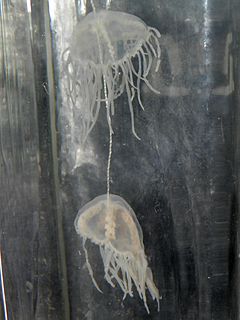
Gonionemus is a genus of hydrozoans that uses adhesive discs near the middle of each tentacle to attach to eelgrass, sea lettuce, or various types of algae instead of swimming. They are small and hard to see when hanging onto swaying seaweed. Nevertheless, they are capable of swimming when necessary. The bell is transparent, revealing the four orange to yellowish-tan gonads that lie along most of the length of the four radial canals. The pale yellow manubrium has four short, frilly lips. Up to 80 tentacles line the bell margin, with about an equal number of statocysts. Copepods are a favored prey.

Turritopsis dohrnii, also known as the immortal jellyfish, is a species of small, biologically immortal jellyfish found worldwide in temperate to tropic waters. It is one of the few known cases of animals capable of reverting completely to a sexually immature, colonial stage after having reached sexual maturity as a solitary individual. Others include the jellyfish Laodicea undulata and species of the genus Aurelia.

Parazoanthus axinellae, commonly known as the yellow cluster anemone, is a zoanthid coral found on the southern Atlantic coasts of Europe and in the Mediterranean Sea. Zoanthids differ from true sea anemones, in having a different internal anatomy and in forming true colonies in which the individual animals (polyps) are connected by a common tissue, called the coenenchyme.
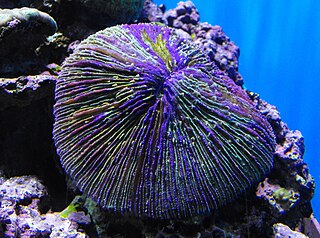
Fungia is a genus of corals in the family Fungiidae. It is monotypic with the single species Fungia fungites, which is found growing on reefs in the Indo-Pacific.

Gonionemus vertens, the clinging jellyfish, is a small species of hydrozoan in the family Olindiidae found in coastal regions throughout large parts of the Northern Hemisphere.

Acropora loripes is a species of branching colonial stony coral. It is common on reefs, upper reef slopes and reef flats in the tropical Indo-Pacific. Its type locality is the Great Barrier Reef.
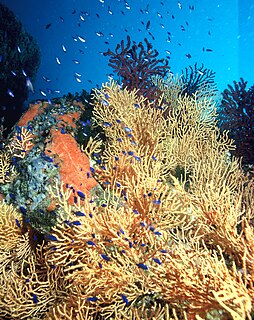
Eunicella cavolini, commonly known as the yellow gorgonian or yellow sea whip, is a species of colonial soft coral in the family Gorgoniidae. It is native to parts of the eastern Atlantic Ocean, Mediterranean Sea and Ionian Sea where it is a common species.

Leptopsammia pruvoti, the sunset cup coral, is a solitary stony coral in the family Dendrophylliidae. It is an azooxanthellate species, meaning its tissues do not contain the symbiotic unicellular algae (zooxanthellae) of the genus Symbiodinium, as do most corals. It is native to the Mediterranean Sea. The species was described by Henri de Lacaze-Duthiers in 1897 and named to honor the French marine biologist Georges Pruvot.

Astroides is a genus of stony cup corals in the family Dendrophylliidae. It is monotypic and the only species is Astroides calycularis, which is endemic to the western Mediterranean Sea. The species was first described in 1766 by the German naturalist Peter Simon Pallas.

Caryophyllia smithii, the Devonshire cup coral, is a species of solitary coral in the family Caryophylliidae. It is native to the northeastern Atlantic Ocean, the North Sea and the Mediterranean Sea. There are shallow and deep-water forms which are structurally different. It forms part of a biodiverse community of rock encrusting organisms and is often parasitised by a barnacle.

Isozoanthus sulcatus is a species of zoanthid in the family Parazoanthidae.

Clavularia crassa is a species of colonial soft coral in the family Clavulariidae. It is found in the eastern Atlantic Ocean and the Mediterranean Sea. It was first described in 1848 by the French zoologist Henri Milne-Edwards from a specimen collected off the coast of Algeria.

Maasella is a genus of soft coral in the family Paralcyoniidae. It is monotypic, with only a single species, Maasella edwardsi. Usually of greenish brown or golden brown color, each polyp has eight pinnate tentacles. This soft coral is found in the Mediterranean Sea and the Atlantic Ocean, at depths of between 2 and 50 metres.
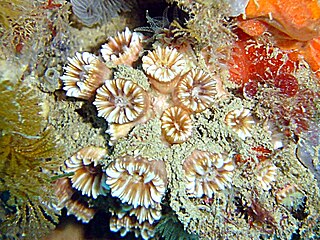
Polycyathus muellerae is a small species of coral in the family Caryophylliidae in the order Scleractinia, the stony corals. It is native to the northeastern Atlantic Ocean and the Mediterranean Sea. It is a large polyp, colonial coral and grows under overhangs and in caves as part of an assemblage of organisms suited to these poorly-lit sites.
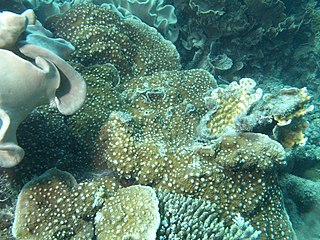
Oxypora lacera, the ragged chalice coral or porous lettuce coral, is a species of large polyp stony corals in the family Lobophylliidae. It is a colonial coral which can be submassive, encrusting or laminar. It is native to the western Indo-Pacific.
Corymorpha nutans is a hydroid in the family Corymorphidae.
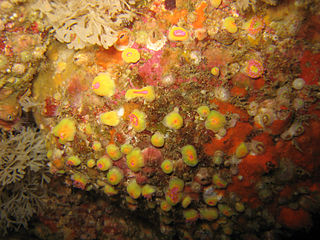
Corynactis viridis, the jewel anemone, is a brightly coloured anthozoan similar in body form to a sea anemone or a scleractinian coral polyp, but in the order Corallimorpharia. It is found in the northeastern Atlantic Ocean and the Mediterranean Sea and was first described by the Irish naturalist George Allman in 1846.

Obelia dichotoma is a broadly distributed, mainly marine but sometimes freshwater, colonial hydrozoan in the order Leptothecata that forms regular branching stems and a distinctive hydrotheca. O. dichotoma can be found in climates from the arctic to the tropics in protected waters such as marches and creeks but not near open coasts like beaches in depths up to 250m. O. dichotoma uses asexual and sexual reproduction and feeds on mainly zooplankton and fecal pellets. Obelia dichotoma has a complex relationship with the ecosystem and many economic systems.



















